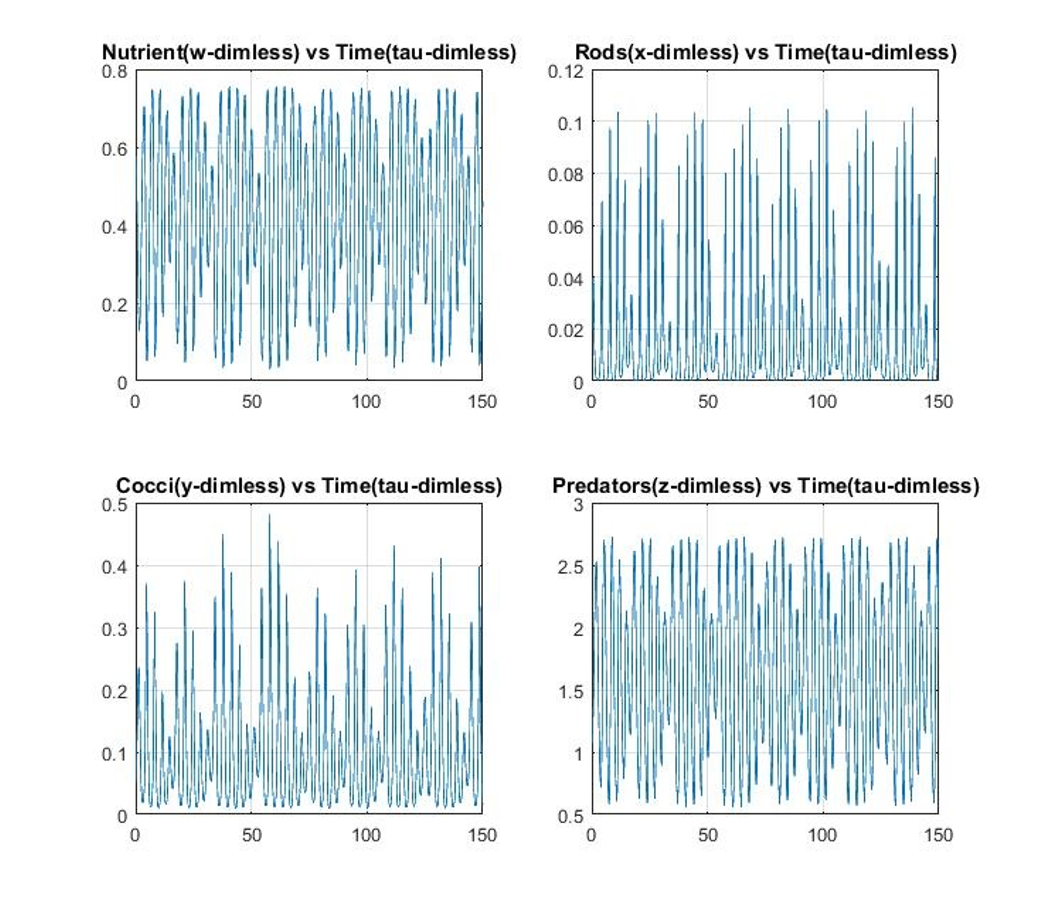




Did you find this useful? Give us your feedback


![Figure 2.3. 3-D system space plots of Equations (4) solution with an inflowing nutrient concentration given by Dn0 = [0.15(1 - 0.5sin(0.52t))]. A strange attractor is evident.](/figures/figure-2-3-3-d-system-space-plots-of-equations-4-solution-2i9a6qsj.png)

![Figure 1.6. Simulated nutrient and microbe dynamics that match the Becks et al. [2005, Fig. 1] results for D = 0.9/d (0.0375/hr).](/figures/figure-1-6-simulated-nutrient-and-microbe-dynamics-that-3u6k06k2.png)













![Figure 1.3. Irregular, non-periodic, dynamics of n(t), r(t), c(t) and p(t) associated with the system-space plot in Fig 1.2. By counting apparent concentration peaks, the mean frequency of the simulated data appears lower than that observed in Becks et al. [2005], but still within 50%. However, the mean model frequency can be selected by changing the dimensionless ratios of max specific growth and death rates to D (Chapter 3).](/figures/figure-1-3-irregular-non-periodic-dynamics-of-n-t-r-t-c-t-l20dtjr7.png)







60 citations
282 citations
...For example, Graham et al. (2007) reported experimental results demonstrating the phenomenon of chaotic instability in biological nitrification in a controlled laboratory environment....
[...]
...Graham et al. (2007) concluded that “nitrification is prone to chaotic behavior because of a fragile AOB-NOB mutualism,” i.e., interaction....
[...]
...Molz and Faybishenko (2013) have recently concluded that three papers (Becks et al, 2005; Graham et al. 2007; Beninca et al., 2008), using experimental studies and relevant mathematics, may provide convincing demonstrations that deterministic chaos is present in relatively simple biochemical…...
[...]
238 citations
...Such an unsolved problem could also be a source of instability in a mathematical model producing DCD that was observed in an experiment....
[...]
...The main objective of this report is to develop an exploratory mathematical analysis motivated by the Becks et al. (2005) experiments, which will be presented in Chapter 1....
[...]
...Molz and Faybishenko (2013) have recently concluded that three papers (Becks et al, 2005; Graham et al. 2007; Beninca et al., 2008), using experimental studies and relevant mathematics, may provide convincing demonstrations that deterministic chaos is present in relatively simple biochemical…...
[...]
...Due to the common observation of extreme sensitivity of mathematical models of ecological/microbial systems producing DCD to parameter variations, we have suggested that something fundamental may be missing from the current mathematical formulations....
[...]
...As written, however, Equations (1.2) do not include information from the supplemental experiments of Becks et al. (2005) or particular information on how a chemostat operates, such as potential nutrient recycling from dying biomass....
[...]
194 citations
...Based on a recent paper by Liepe et al. (2013), there is increasing interest in information concepts related to systems biology....
[...]
181 citations
...This inverse relationship between uncertainty and information is what makes Shannon’s measure so confusing when calling it some type of “information”, and as pointed out by Ben-Naim (2008, 2015), there is an immense amount of confusion in the public literature....
[...]
...…P i n = = −∑ , which is equivalent to: 1 1 2 1 ( ) ( ) ( ) i i i i r rn r r r i r r SM n PF r dr Log PF r dr + + = ⎡ ⎤ ⎡ ⎤ = − ⎢ ⎥ ⎢ ⎥ ⎢ ⎥ ⎢ ⎥⎣ ⎦ ⎣ ⎦ ∑ ∫ ∫ (4.8) With several additional steps, Ben-Naim (2008) shows that as n → ∞, Equation (4.8) becomes: 2 2 lim( ) [ ( )] b r r r a b aSM PF r Log…...
[...]
...In fact, Ben-Naim (2008) argues convincingly that temperature should have the units of energy, not degrees, making the statistical mechanical interpretation of thermodynamic entropy dimensionless and identical formally to Shannon entropy, although Shannon entropy can apply to probability…...
[...]
...Transformation to the continuous case is presented in Appendix I of Ben-Naim (2008), and we will outline his procedure below....
[...]
...As described in his two clearly written and highly recommended books, Ben-Naim (2008, 2015) describes the puzzling nature of the concept of Shannon Information....
[...]
101 citations
The potential relation of chaotic dynamics to the appropriate information flows, being careful of what “ information ” actually means in an ecological context, appears very interesting, and it should be considered as a prime area for future research.